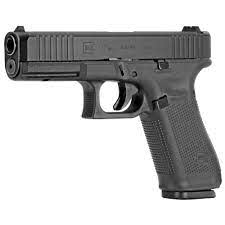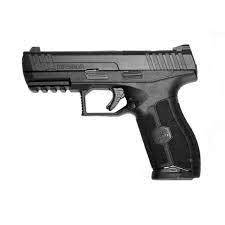The Ruger 10/22 carbine: Unleashing the Power and Precision of America’s Favorite Rimfire Rifle In the world of rimfire rifles, one stands head and shoulders above the rest: the Ruger 10/22 .22LR.
This iconic firearm has earned the affection of shooters across America, and it’s not hard to see why. With its exceptional power and unmatched precision, the 10/22 has cemented its place as a favorite among gun enthusiasts.
The Ruger 10/22 carbine combines a sleek design with unrivaled performance. Its reliability and easy handling make it a perfect choice for everyone from beginners to seasoned marksmen.
Whether you’re heading to the range for some target practice or venturing into the great outdoors on a hunting trip, this rifle excels in both accuracy and versatility.
Crafted with meticulous attention to detail, the Ruger 10/22 .22LR showcases the finest craftsmanship and quality that Ruger is known for.
Each component has been engineered to deliver optimal performance, ensuring that every shot fired is a testament to precision and power.
Join us as we delve into the features and innovations that have made the Ruger 10/22 .22LR America’s favorite rimfire rifle. Discover why this firearm has gained such a loyal following and why it continues to dominate the market today.
Built-in American factories by American workers, every 10/22 rifle that comes off the line is a quality firearm.
With millions sold over a span of more than half a century, the Ruger 10/22 has long been America’s favorite rimfire rifle.
When it comes to choosing your next .22 rifle, don’t settle for an imitation, make it an original.
The .22 LR Ruger 10/22 Carbine: An American Classic
I’ve often said a .22 rimfire rifle is the ideal firearm for learning all the basics to becoming a competent shooter with all firearms.
Since the introduction of the .22 LR cartridge in 1887, learning to shoot with a .22 rifle has become something of a tradition. But .22 rimfire rifles aren’t just for beginners.
They are essential for any shooter and can be used in many places where centerfire rifles can’t. Every shooter should own at least one .22 rimfire rifle. And the Ruger 10/22 Carbine is an excellent option.
My first .22 rimfire rifle was a Ruger 10/22 Carbine, a purchase I made around 1974 with some gift money and my father’s guidance.
Derived from the Ruger .44 Magnum semi-automatic carbine introduced in 1961, the slightly smaller Ruger 10/22 entered the market in 1964.
Its hardwood stock and lightweight design remind me of the WWII U.S. .30 caliber M1 Carbine. And the revolutionary Ruger 10-round rotary magazine that fit flush in the stock provided reliable operation and easy loading.
Today, the Ruger 10/22 is available in multiple configurations spanning eight categories, including carbine, sporter, tactical, the Ruger collectors series and more.
This extensive lineup all originates from William B. Ruger’s innovative design. Yet, despite the variety, the classic Ruger 10/22 Carbine remains largely unchanged, preserving its timeless appeal and functionality without succumbing to unnecessary modifications.
The few changes made to the classic Ruger carbine are marked with an asterisk (*) in the below list of specifications.
Shooting Experience with the Ruger 10/22 Carbine
Revisiting the Ruger 10/22 Carbine is like reuniting with an old friend. Its reliability and feel remain impressive. The 10/22 Carbine snaps to the shoulder quickly.
And though curved buttplates are known for being uncomfortable on large caliber hunting rifles, it is natural for the 10/22 Carbine because of its zero recoil. It helps the place the rifle consistently on the shoulder in the proper location regardless of shooting position.
I took my son Owen along to the range for a test. I wanted to find him a better rifle for the 2024 Project Appleseed Rifle Clinic coming up soon, a program I highly recommend.
Previously, many of the competitors used Ruger 10/22s of one type or another. I thought we ought to try one for ourselves.
In order to make handling easier for a 9-year-old, I felt it best to stick with the lightweight classic design, which could be used for a wide range of shooting activities.
Since the lightweight 3×9 variable optic I ordered for the 10/22 hadn’t arrived yet, our first outing to the range was to check function and to make sure he could handle the 10/22 in the required shooting positions.
Using the Correct Ammunition
I brought along the included flush-fit 10-round magazine as well as the 15-round Ruger magazine that came with his Ruger Charger.
Owen particularly favored the 15-round magazine due to its fumble-free design and additional gripping position.
We didn’t have a lot of time, so I brought along a single box of American Eagle (Federal) .22 Long Rifle high-velocity 38-grain copper-coated hollow-point ammunition with a muzzle velocity of 1260 feet per second from a rifle.
For those not familiar with semi-automatic .22 caliber rifles, it is critical you use only high-velocity ammunition.
Standard velocity, target velocity or suppressor ammunition fired without a suppressor attached will not have enough “oomph” to cycle the blowback action.
High-velocity solid lead bullets should have a slight accuracy edge over lead hollow-point loads.
I verified the zero of the 10/22’s fixed sights using a Bog Pod rest from 60 feet, firing from the prone position on a Project Appleseed Qualification Test Target.
My group measured 3.5 inches and centered just to the right on the Stage 2 target. Not bad considering I wear progressive trifocal glasses.
Owen was next, and the Ruger 10/22 Carbine fit him like a glove. He shot from a self-supported traditional prone position for the first time.
He also fired the 10/22 from the kneeling position. He was solid in both shooting stances. He was happy with the trigger pull and fired some decent first-time groups from both positions.
There was only one failure to feed malfunction. However, some CLP-type lubricant applied to the bolt solved the problem.
Who Should Own a Ruger 10/22 Carbine?
The Ruger 10/22 Carbine continues to be as versatile and dependable as when it was first introduced in 1964.
The rifle’s adaptability to both youth and adults alike without modification is truly remarkable. Although I am reviewing it here as a youth gun, the 10/22 is for shooters of any age, stature or level of experience.
Suitable for a wide range of shooting activities, from plinking to small game hunting and even home defense, it is a quintessential firearm for any age or skill level.






Maura –
nice product and the price is awesome
Tonia –
i didnt like how it was shipped, the scope was broken before it got to me smh, i hope you guys can fix this. i submitted my problem with pictures to your email
Tyree –
i so much love this rifle. thank you guys so much
Jacelyn –
how can i order bullets for 10/22 rifle?
Joe –
do you have a scope for this rifle?